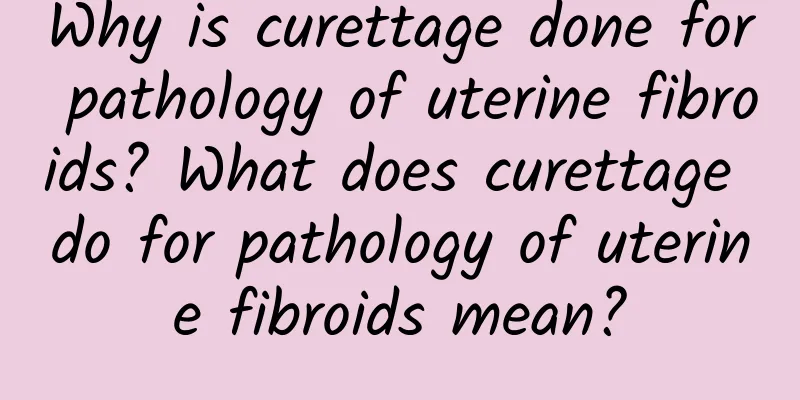Why is curettage done for pathology of uterine fibroids? What does curettage do for pathology of uterine fibroids mean?

|
Why do we need to do curettage and pathology for uterine fibroids? What does it mean to do curettage and pathology for uterine fibroids? Among gynecological diseases, uterine fibroids are a very common benign tumor. They are mainly composed of endometrium and uterine wall tissues, and usually do not cause malignant changes, but they can also have a certain impact on women's quality of life. In order to confirm and determine the characteristics of uterine fibroids, doctors usually use a series of methods such as ultrasound, clinical examination and curettage. So, why do people with uterine fibroids undergo curettage for pathological examination? Uterine fibroids curettage and pathology is a diagnostic method. The tissue specimens obtained through curettage can be analyzed pathologically, and the cell morphology and tissue structure can be observed under a microscope to determine whether it is a uterine fibroid. This method can confirm the diagnosis and rule out the possibility of other uterine diseases. Uterine fibroids curettage and pathology can determine the type of fibroids. Uterine fibroids are divided into different types, such as serous, fibroid, endometrial, etc. Through curettage, doctors can obtain fibroid tissue and determine the specific type through pathological examination. This plays an important guiding role in formulating subsequent treatment plans and controlling the progression of the disease. Next, let's look at some specific applications of curettage for uterine fibroids for pathology, some of which use serial numbers to better illustrate the point: 1. Pathological examination can determine the risk of malignant transformation of fibroids. Sometimes, the cytological characteristics of uterine fibroids may be similar to those of malignant tumors. Through pathological examination, the degree of cell mutation of fibroids can be evaluated, and whether there is a risk of malignant transformation can be determined, so as to formulate a reasonable treatment plan. 2. Pathological examination after curettage can observe the blood supply of fibroids. The growth of fibroids requires a large amount of blood supply. Through pathological examination, doctors can observe the richness of blood vessels in fibroids, abnormal blood vessel formation and other characteristics, which helps to understand the growth pattern of fibroids and possible treatment strategies. 3. Pathological examination after curettage guides preoperative preparation and surgical selection. If the fibroid is large or has unusual pathological characteristics, the doctor may recommend surgical treatment. Through pathological examination, the nature of the fibroid can be more fully understood, so as to choose the appropriate surgical method, such as fibroid removal, hysteromyomectomy, etc. Uterine fibroid curettage and pathology is an important diagnostic method that can clearly diagnose uterine fibroids and determine their types, assess the risk of malignant transformation, and guide the formulation of subsequent treatment plans. For gynecologists, it is very important to master and apply pathology techniques in order to provide more accurate and personalized diagnosis and treatment services so that patients can get better treatment results. |
Recommend
Eating a concentrated starch dinner can speed up the secretion of leptin and help you lose weight faster? Nutritionist: Be careful of the risk of "this"
Should you eat starch during weight loss? How to ...
What is the cause of female cervical erosion? 3 treatments for female cervical erosion
Women are fragile. If they don't take care of...
What are the dangers of pelvic inflammatory disease in women?
What are the hazards of female pelvic inflammator...
There are many reasons why women suffer from menstrual irregularities.
In life, many women have irregular menstruation d...
What are the health care issues for menopausal women?
In today's society, due to the influence of v...
Causes of cervical warts
Cervical warts are a common gynecological disease...
Dietary treatment for functional uterine bleeding
Using food to treat and prevent diseases has a lo...
Does cervical precancerous lesions affect life expectancy?
Once a woman gets married and has sex, it is diff...
Li Ying loves eating grapes to promote metabolism and weight loss! Grapes with meals and exercise for 30 minutes will double the effect
Grape is a very popular fruit. It not only tastes...
How long does it take to get pregnant after a miscarriage? This article will show you how
Whether it is a natural miscarriage or an abortio...
What are the daily care aspects of cervical hypertrophy?
Suffering from cervical hypertrophy should not on...
Which comes first, leucorrhea or menstruation?
In a normal menstrual cycle, leucorrhea usually a...
Symptoms that women experience after suffering from uterine fibroids
Among tumor diseases, there is a more common gyne...
Why does hydatidiform mole occur?
Why does hydatidiform mole occur? Speaking of hyd...
Principles of preventing ectopic pregnancy in daily life
Many women have only a limited understanding of e...









